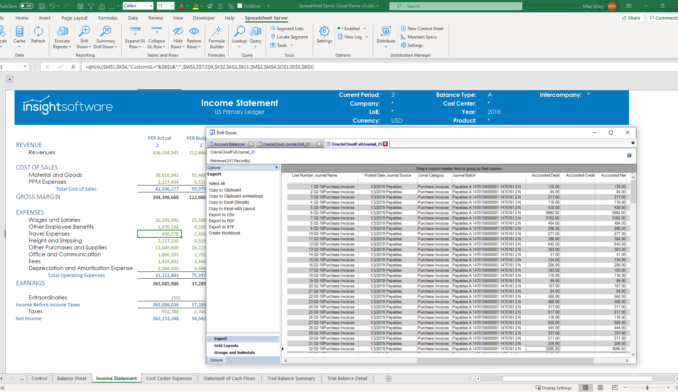From IT Dependence to Ad Hoc Reporting: Why and How

It’s an all-too-familiar scenario: You’re deep into the month-end closing process, and a recent change in the enterprise resource planning (ERP) system necessitates the modification of some of the key reports you rely on every month. Everybody in IT has gone home for the day, but even if they were still in the office, it’s likely that they would give you an estimate of two or three days (or possibly much longer) to complete the necessary modifications. You resolve to assemble the information manually by copying and pasting information into a spreadsheet. It’s slow and tedious, but eventually it gets the job done—hopefully you didn’t make any mistakes along the way.
This is just one example of what can happen when you have an immediate reporting requirement, but you’re completely dependent on the IT department to make any necessary changes to your existing library of reports. In many cases, those kinds of modifications might not require a lot of time or effort, but they do require specialized technical expertise. In most organizations, the IT department is kept busy, so there can often be a backlog of service requests, leading to long delays. In other cases, companies must turn to expensive outside consultants who charge hundreds of dollars per hour for the work.
Similar situations arise when management is looking for answers to questions that haven’t necessarily come up routinely in the past. At times like these, a dependency on trained technical experts is a liability. It causes delays and costs money. It also ties up valuable resources that may be badly needed elsewhere.
Fortunately, there is a better way to get ad hoc reporting done. Finance teams need not be dependent on external resources. With the right financial reporting tools, members of the accounting team can design their own ad hoc reports from scratch, enabling them to quickly and easily develop analytical tools that might otherwise have taken days or weeks to produce.
The Problem with Traditional Approaches to Reporting
Most accounting and ERP systems come with their own built-in report writers. Unfortunately, these tend to fall short of the mark when it comes to usability and robustness for financial reporting. They simply don’t work well for financial analysis because they lack the ability to add formulas, pivot tables, “what if” scenarios, and so on.
Designing an ad hoc report often involves navigating arcane features and delving into the details of ERP database tables. Built-in tools are often inflexible, lacking the ability to link information from different data sources, or sometimes even from different modules within the same ERP system.
The results of these limitations are usually fairly predictable: finance and accounting staff end up exporting data from their ERP system, importing it into a spreadsheet, and then doing their reporting and analysis from there.
Microsoft Excel is a favorite tool of choice for finance teams around the world because it is easy to use while also being remarkably flexible and powerful. Excel is ubiquitous; virtually every computer has a copy installed, and it has become the go-to solution for most people whenever they have a need to perform some numbers-crunching.
There are a few problems with the simple export/import or copy/paste scenario, though. First, it’s tedious and time-consuming to manually copy and paste information, or to reformat data that has been exported from ERP and subsequently imported into a spreadsheet. Second, it has a tendency to introduce errors. When you copy and paste a fresh batch of data into an existing spreadsheet, for example, you can miss information if new rows were added and formulas have not been adjusted accordingly. Those kinds of errors can be difficult to locate. Since you use most financial reports to inform important business decisions, inaccuracies can be costly.
Another problem is that such reports are static. When you use this manual copy/paste process for financial reports, it produces information that is outdated starting from the moment you create the report. Data you exported merely serves as a copy of what was in the ERP system at a single moment in time. Typical spreadsheet-based reports can’t update that information without even more manual effort.
While all of these limitations add up to big problems, the good news is that a spreadsheet can still work well as an ad hoc reporting tool, provided that it’s working in conjunction with robust, purpose-designed tools that understand your ERP data and provide live links between the spreadsheet and the information in your accounting/ERP system.
Independence from IT
Freeing your team from dependency on the IT department may sound like a tall order, but there are steps that can bring you closer to that goal. Wherever possible, create automated reports that can be easily refreshed without IT’s help, using real-time data so that the viewers of reports can dig into the data for themselves. Consider switching to a tool that is designed with ease-of-use in mind. Such tools typically require fewer technical skills and afford users much broader flexibility in creating and modifying reports. Purpose-built dashboards provide powerful visualizations that inform and educate a broad range of users. Tools that allow members of the finance team to directly connect to live ERP data through Excel make ad hoc analysis much simpler, faster, and more flexible.
Robust, purpose-designed reporting tools from insightsoftware make it possible to pull data directly from your ERP system (or even from multiple disparate systems) in near real time, and then to work with that information in a spreadsheet format. That allows finance and accounting (F&A) professionals to perform ad hoc analysis, inserting formulas and benefiting from familiar spreadsheet features and functionalities. With insightsoftware’s financial reporting tools, finance users can modify report contents themselves, using familiar tools, and without any help from the IT department.
When F&A professionals can produce their own reports, it removes friction from the financial reporting and analysis processes. Finance team members can get exactly what they want, when they need it. If your organization wants a better way to do ad hoc reporting, insightsoftware can help. Request a free demo to see it for yourself.










